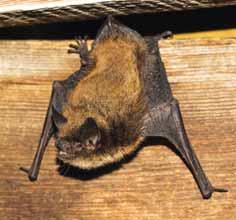
4 minute read
The World of Bats
BY CATHY DENHAM
As a child, I was frightened of bats. Like others, I believed that they could get tangled in my hair or give me rabies. I’ve heard the only way to cure rabies was lots of shots directly into the stomach. It’s horrible to even imagine that.
I’ve learned to admire bats and understand the importance of protecting them and their habitats. It’s amazing to watch them flying around at night, darting through the air and eating hundreds of mosquitoes. I was excited to have the opportunity to attend a bat count.
That evening, with a chair and a bat counter, I sat with other participants and patiently waited until dark for them to emerge. When they did, they literally poured out into the night. It was incredible to watch. There were so many, it was di fficult to click fast enough especially since I was mesmerized by the colony’s population. They were a mixture of Yuma and little brown bats, I think.
Bats range in size from the tiny bumblebee bats to the large flying foxes that have a wingspan of up to six feet. There are over 1,400 known species that greatly vary in colour and appearance. In Mid Island area, there are only about 10 different species.
Being nocturnal, they are active at night. They use a sonar system to navigate and fi nd their prey. By creating high-frequency sounds and interpreting the echoes that bounce back, they locate insects, objects and other animals with remarkable precision.
Our bats are insect eaters and consume huge numbers of mosquitos each night. Bat guano (poo) is rich in nutrients and is used as a valuable fertilizer. Indeed, bats are vital in helping to maintaining the health of our forests and other plant communities.
Bats are considered as an indicator species. Being sensitive to changes in the environment, their presence, absence and behaviour provide valuable information about the ecosystem’s health. But their recent prognosis isn’t great. Habitat loss, disturbance of roosting sites, climate change and diseases like the decimating white-nose syndrome, recently found in Grand Forks, BC, is concerning.
Bat counts are crucial to knowing more about them, and it’s great to have the chance to attend a count.
The BC government sponsors some counts that take place outside identified roosts, in abandoned houses, barns, church steeples and even occupied structures that provide a roosting and nursery for bats and their pups. Four annual counts usually take place each summer.
The little brown Myotis relies extensively on human-made structures as sites for roosting and raising offspring. Stewardship and management of bats and bat colonies and their roost sites is important for the future of bats in the province. Communities can become provincially certified as bat friendly.
These are places where their habitats are valued and protected even in the Local Area Planning process. Citizens are

engaged in educational and stewardship activities to protect bats and bat habitat. Within BC, Peachland, Delta, Richmond and Dawson Creek are such communities. Both Metchosin and Denman Island have bats living in community buildings, and they are fundraising to provide a live webcam to help the public observe their bats behaviour.
Last February, the North Oyster and Area Historical Society, in conjunction with the BC Community Bat Program, held a public meeting about bats. It was very well attended, and many participants shared their stories about living with bats on their property.
Bats often live in buildings without causing any issues to landowners, but there are important procedures and safety precautions to make sure you and the bats stay safe.
More information on living with bats: https://www.youtube.com/channel/UCGcqaQng0XFnLV0rIjzrlXw/videos.
For more information, please contact the BC Community bat program at www.bcbats.ca.




